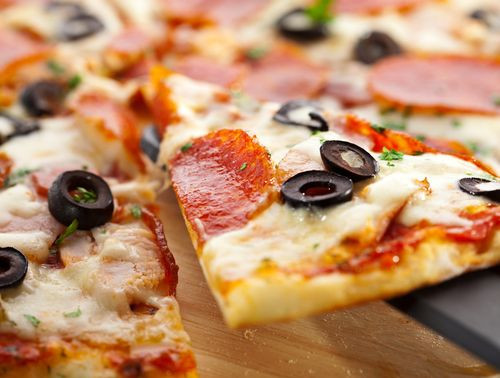Healthy Pizza: Scientists Nutritionally Balance America’s Favorite Food

It’s easy to forget sometimes — in the middle of a eating a slice of pizza that’s just bathing in grease and oil and cheese, lulling you into a pepperoni stupor — that food keeps us alive. Or at least it should. That was the motivation behind one research team’s mission to design the first nutritionally balanced pizza, one that contains enough vitamins, minerals, nutrients, and the appropriate breakdown of protein, carbohydrates, and fat so that you could eat it for every meal of the day.
As judged by Oxfam International, a global hub of organizations seeking to end poverty worldwide, there’s no contest for America’s favorite food. It’s pizza — by a landslide. In fact, it’s nearly twice as popular as the runner-up, steak. But pizza isn’t perfect, at least not nutritionally. Supermarkets sell a dizzying amount of pizza options in their frozen food section, and nearly all of them contain egregiously high levels of saturated fat and salt. Scientists say they have a solution.
“Traditional pizza should be a low-fat meal containing at least one portion of vegetables, so mainly made from ingredients associated with better cardiovascular health,” said Prof. Mike Lean, physician and nutritionist at the University of Glasgow School of Medicine. "Until now, nobody has stopped to notice that many essential vitamins and minerals are very low or even completely absent. From a nutrition and health perspective, they are hazardous junk.”
Together with a team of scientists, Lean and his colleagues analyzed 25 commercially available Margarita pizzas. Calorie content varied widely among the pizzas, while many contained similarly high levels of fat and sodium and equally low levels of nutrients.
Most of the pizzas contained sufficient carbohydrates, roughly 45 percent being necessary for one meal, according to the researchers. None of the pizzas met all the requirements outlined for a nutritionally balanced meal, they added. However, they did find each pizza satisfied the criteria when considered in the aggregate, meaning a nutritionally balanced pizza was possible.
"Some were really bad,” Lean admitted. “While none of the pizzas tested satisfied all the nutritional requirements, many of the requirements were met in some pizzas, which told us it should be possible to modify the recipes to make them more nutritionally-balanced without impacting on flavor – health by stealth, if you like."
The findings led Lean and his team to the folks at EatBalanced.com to devise a nutritionally sound pizza recipe that still pleased the taste buds. Their approach included reducing salt, adding whole-wheat flour, adding a small amount of Scottish seaweed in place of salt, including vitamin B12 and fiber, iron, vitamin A, vitamin B12 and iodine, and adding red peppers to boost vitamin C levels. The end product contained roughly 30 percent of a person’s daily intake for each important marker.
"There really is no reason why pizzas and other ready meals should not be nutritionally-balanced,” Lean remarked. “We have shown it can be done with no detriment for taste.”
Up next for Lean and his culinary colleagues is nutritionally balanced curry, followed by healthy fish and chips. He called upon large food manufacturers to take nutrition into consideration more often when creating their meals, as the public reliance on quick, microwavable entrees shouldn’t have to demand sacrificing health for convenience.
“We can't all make entirely home-made meals, so it's about time that manufacturers took steps to make their products better suited to human biology, and we have shown then how to do it,” he said. “Rather than sneaking in additives like salt, they could be boasting about healthier ingredients that will benefit consumers."
Published by Medicaldaily.com



























